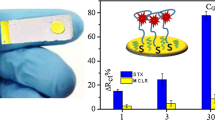Abstract
A new immunoassay for continuously monitoring atrazine in water has been developed. It uses a portable biosensor platform based on surface plasmon resonance (SPR) technology. This immunoassay is based on the binding inhibition format with purified polyclonal antibodies, with the analyte derivative covalently immobilized on a gold sensor surface. An alkanethiol self-assembled monolayer (SAM) was formed on the gold-coated sensor surface in order to obtain a reusable sensing surface. The low detection limit for the optimized assay, calculated as the concentration that produces a 10% decrease in the blank signal, is 20 ng/L. A complete assay cycle, including regeneration, is accomplished in 25 min. Additionally, a study of the matrix effects of different types of wastewater was performed. All measurements were carried out with the SPR sensor system (β-SPR) commercialised by the company Sensia, S.L. (Spain). The small size and low response time of the β-SPR platform would allow it to be used in real contaminated locations. The immunosensor was evaluated and validated by measuring the atrazine content of 26 natural samples collected from Ebro River. Solid-phase extraction followed by gas chromatography coupled to mass spectrometric detection (SPE–GC–MS) was used to validate the new immunoassay.





Similar content being viewed by others
References
Cooper RL, Stoker TE, Tyrey L, Goldman JM, McElroy WK (2000) Toxicol Sci 53:297–307
Sathiakumar N, Delzell E (1997) Crit Rev Toxicol 27:599–612
EC (1998) Off J Eur Commun L330:32
Patty L, Bruchet A, Jaskulke E, Acobas F, Van Hoof F, Sacher F, Bobeldijk I, Ventura F, Marecos do Mote MH (1998) TSM Hydrol Hydraul 9:24
Di Corcia A, Crescenzi C, Guerriero E, Samperi R (1997) Environ Sci Technol 31:1658–1663
Koeber R, Fleischer C, Lanza F, Boos K-S, Sellergren B, Barcelo D (2001) Anal Chem 73:2437–2444
Rodriguez-Mozaz S, López de Alda M-J, Barceló D (2004) J Chromatogr A 1045:85–92
Jeannot R, Sabik H, Sauvard E, Genin E (2000) J Chromatogr A 879:51–71
Dagnac T, Bristeau S, Jeannot R, Mouvet C, Baran N (2005) J Chromatogr A 1067:225–233
Graziano N, McGuire MJ, Roberson A, Adams C, Jiang H, Blute N (2006) Environ Sci Technol 40:1163–1171
Rodriguez-Mozaz S, López de Alda MJ, Barceló D (2006) Talanta 69:377–384
Rodriguez-Mozaz S, Reder S, Lopez de Alda MJ, Gauglitz G, Barceló D (2004) Biosen Bioelectron 19:633–640
Mauriz E, Calle A, Lechuga LM, Quintana J, Montoya A, Manclús JJ (2006) Anal Chim Acta 561:40–47
Lim T, Oyama M, Ikebukuro K, Karube I (2000) Anal Chem 72:2856–2860
Nakamura C, Hasegawa M, Nakamura N, Miyake J (2003) Biosen Bioelectron 18:599–603
Shimomura M, Nomura Y, Zhang W, Sakino M, Lee KH, Ikebukuro K, Karube I (2001) Anal Chim Acta 434:223–230
Homola J (2003) Anal Bioanal Chem 377:528
Gascon J, Oubina A, Ballesteros B, Barceló D, Camps F, Marco M-P, Gonzalez-Martinez MA, Morais S, Puchades R, Maquieira A (1997) Anal Chim Acta 347:149–162
Manson MM (ed)(1992) Immunochemical protocols (Methods in Molecular Biology 10). Humana, Totowa, NJ
Ferretti S, Paynter S, Russell DA, Sapsford KE, Richardson DJ (2000) Trends Anal Chem 19:530
Mauriz E, Calle A, Montoya A, Lechuga L (2006) Talanta 69:359–364
Lacorte S, Guiffard I, Fraisse D, Barceló D (2000) Anal Chem 72:1430–1440
Acknowledgements
This work was funded by the EU Project SWIFT WFD (Contract SSPI-CT-2003-502492) and the Ministry of Science and Technology (project number CTM2005-24255E) and (Contract number TEC20004-0121-E) and by the European Community (IST-2003-508774). The AMR group is a consolidated Grup de Recerca de la Generalitat de Catalunya and has support from the Departament d’Universitats, Recerca i Societat de la Informaciá la Generalitat de Catalunya (expedient 2005SGR 00207).
Marinella Farré thanks the Juan de la Cierva Program of the Ministerio de Educación y Ciencia, and Javier Ramón thanks the I3P program of the CSIC. This work reflects only the authors’ views, and the European Community is not liable for any use that may be made of the information contained therein. Thanks to Sensia, S.L. for their loan of the SPR instrument.
Author information
Authors and Affiliations
Corresponding author
Rights and permissions
About this article
Cite this article
Farré, M., Martínez, E., Ramón, J. et al. Part per trillion determination of atrazine in natural water samples by a surface plasmon resonance immunosensor. Anal Bioanal Chem 388, 207–214 (2007). https://doi.org/10.1007/s00216-007-1214-2
Received:
Revised:
Accepted:
Published:
Issue Date:
DOI: https://doi.org/10.1007/s00216-007-1214-2




